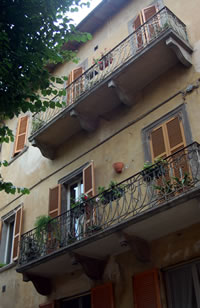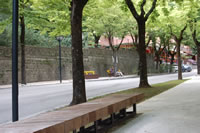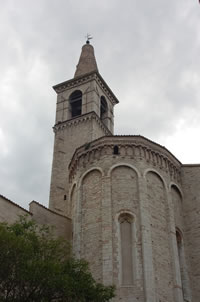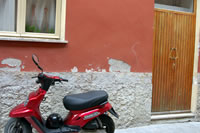Building on the past
Preservation and construction
in majestic Cagli
Text by Lena Marchese
Everyone has a different idea of place, but what Italy undoubtedly offers is majestic cathedrals, ancient stone churches, winding cobblestone streets lined with homes in warm rich colors, dramatic mountains and lively piazzas filled with cafes and places of leisure and friends. Welcome to Cagli, Italy, in the north of the Marche region.
Cagli has a history dating back to 200 B.C., and, along with the beautiful architecture, a strong community feeling that has withstood the test of time. Italo Grilli, a local architect and a Cagliese through and through, believes in preservation. Although he attended school in Urbino, Bologna, and London, he never wondered if he would return to Cagli - only when.
Grilli works for the city of Cagli and also has his own private practice and looks the part. With his graying, wavy hair and shiny leather shoes, he smokes a rather expensive looking pipe as he explains that ever since he was young he wanted to be an architect, an urge that in turn has driven him to create and restore works for the city that is his home.
Anyone walking through Old Cagli, the historic section of the city, would know this small town is rich in history and architecture. The centuries-old weathered stone buildings still have a majestic appearance. If anything, the erosion of the stone blocks adds to the power of the buildings and leaves one to wonder what these walls have seen. The Cagliese want these structures to endure the test of time.

This is where the restoration of the older buildings in Cagli comes into play. The Piano Particolareggiato Centro Storico, PPCS, is an organization that supports the preservation of older buildings in historic centers of cities and towns. Over time, many small earthquakes have worn away at the foundations of these buildings, and there has been a sharp rise in restoration in the last 15 years to ensure the foundations stay strong.
The cost of extensive restorations can range anywhere from €600 to €1000 per square meter ($92 to $142 per square foot), while less involved work costs €200 to €500 per square meter. Grilli says many people pay for restorations out of their own pockets instead of waiting for the city to get around to giving them help.
Property costs in Cagli depends largely on the extent of restoration work. Buildings that have not been restored can be purchased for around €1000 per square meter, but restored properties average around €2000 per square meter.
There is a history to the "casas" in Cagli, a "casa" being a free-standing house or an apartment. In the historic section, most are apartments rather than houses. In commercial sections, in the past, the ground floor contained a shop or a business, while the second floor would be a kitchen and the top floor would contain bedrooms. In residential buildings, the ground floor is the "cantina" or new lounge.

Although the price between renovating and buying property in Old Cagli differs greatly, Grilli says residents are split half and half when it comes to renovating versus buying. It all depends on the economic situation of the individual.
In 200, Italy, like most of Europe, abandoned its traditional currency - in this case the lira - in favor of the Euro. Grilli says the change caused an "economic crisis." About 2,400 lira was equal to one euro, and Grilli claims the change increased prices by 50 percent. As a result, the real estate market has slowed down drastically here in Cagli. After the change in currency, Cagliese were afraid to spend money because the cost of living is very high in Italy. Electricity is much higher than the average in the United States, and for reasons such as these, people only buy a house when it is absolutely necessary. They would rather renovate their house than go and buy a new one.

Renting property in Old Cagli can range anywhere from €300 to €500 per month.
New Cagli has a slightly lower price range but a dramatically different look from Old Cagli. Where Old Cagli is full of historic buildings, New Cagli very much resembles a suburban American town. It is composed mainly of newer houses built over the last 20 years or so and is quiet during the day as most of the residents come to Old Cagli to work in the cafes and other shops. To buy property in New Cagli, Cagliese expect to pay €1000 to €1800 per square meter, slightly less than Old Cagli, but to rent is roughly the same, around €300 to €500 per month.
In the countryside, the process is slightly different. For starters, property in the countryside is sold as a single property as opposed to a price per square meter. Many of the houses in the countryside are very run down, without roofs or without pavement, so the cost to renovate properties such as these would be enormous.
Grilli says he has never received inquiries from Americans to buy property in Cagli, and only two Americans currently live in the city. But purchasing property here, he says, is no more difficult for Americans than for Italians. With a playful smile on his face, he says the main difference would be converting American dollars to euros.

The south of the Le Marche region has a high concentration of German people, according to Grilli, there are some English, German, and Dutch who own property here in Cagli, but most are Italian. Most people were born and raised here. They will leave to go to school, like he did, but they always come back. The houses stay in the families.
Grilli has many brochures on his work and architecture and engineering in general, but his biggest one is on cheese. Grilli says, "To be a good architect, you have to know good cheese." But don't ask why because his only answer is, "You can't ask why. You just have to understand."
What that means, one may never know, but reading this article is not enough to understand what this beautiful city is like. You can ask why until you are blue in the face, but you have to understand that nothing compares to seeing the real thing.

![]()

